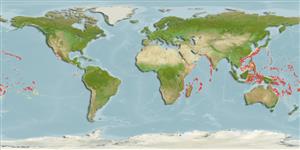Malacostraca |
Decapoda |
Raninidae
Environment: milieu / climate zone / depth range / distribution range
Ecology
Benthic; depth range 150 - 465 m (Ref. 87865). Deep-water
Indo-Pacific: East Africa to Philippines, Australia and Ducie Island.
Length at first maturity / Size / Weight / Age
Maturity: Lm ? range ? - ? cm
One of the most rarely collected Raninidae species (Ref. 87865). Found in deep waters at depths of 100 m or more (Ref. 77016).
Life cycle and mating behavior
Maturity | Reproduction | Spawning | Eggs | Fecundity | Larvae
Members of the order Decapoda are mostly gonochoric. Mating behavior: Precopulatory courtship ritual is common (through olfactory and tactile cues); usually indirect sperm transfer.
Dawson, E.W. and J.C. Yaldwyn 2002 Extension of range of Notopoides latus (Brachyura: Raninidae) to the Eastern South Pacific, with a correction to its original figured shape. Journal of Crustacean Biology 22(1):201-205. (Ref. 87865)
IUCN Red List Status
(Ref. 130435: Version 2025-1)
CITES status (Ref. 108899)
Not Evaluated
Not Evaluated
Threat to humans
Human uses
| FishSource |
Tools
More information
Trophic EcologyFood items (preys)
Diet composition
Food consumption
Predators
Population dynamicsGrowth
Max. ages / sizes
Length-weight rel.
Length-length rel.
Length-frequencies
Mass conversion
Abundance
Life cycleReproductionMaturityFecunditySpawningEggsEgg developmentLarvae PhysiologyOxygen consumption
Human RelatedStamps, coins, misc.
Internet sources
Estimates based on models
Preferred temperature
(Ref.
115969): 11.4 - 20, mean 15.2 (based on 134 cells).
Price category
Unknown.
